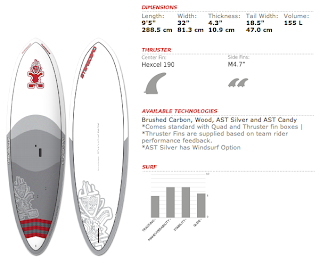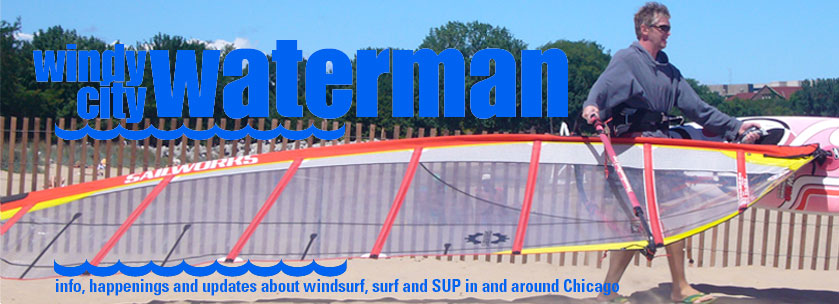As I mentioned in my last post, I'm in the process of testing a fleet of 6 SUP surfboards of different sizes and shapes to shed some light on what makes a great Great Lakes surf SUP. In order to understand what makes these boards different, let's go over some basic board design elements that we'll also use as test criteria. Here are the basic design characteristics we'll be looking at:
1. Size - By size we mean the board's dimensions (that's length, width, thickness and volume). As a rule, bigger people and less experienced surfers should be on bigger boards.
2. Outline - This is the board's basic shape when you look at it deck side up, straight on. Notice how the rails curve, where the widest area of the board is and how narrow it gets (or doesn't get) toward the tail.
3. Rocker - Rocker is the curve the board has when you look at it from the side. More rocker makes a board look something like a banana, and less rocker makes it look flat.
4. Bottom Shape - Many people don't even look at bottom shape when choosing a board, which is a big mistake. A lot of a board's performance comes from subtle, precise shaping that the board's designer carves into the blank. Bottom shapes can be simple or complex, but the theme here is flow. Bottom shape is all about how the water flows under the board.
5. Fin Setup - Boards come with different fin setups - single-fins, thrusters (three fins) and quads (four fins) are the most common.
As I test these boards I'll go over the design characteristics and talk about how they affect the ride. I'll also offer recommendations on what type of surfer and conditions the board would work well for. The first board I'll be reviewing is the Starboard Wide Point 9'5", which I'm riding in the photo above. I've had this board since last August and I've surfed it a lot, both on the Great Lakes and in ocean waves in New York and New Jersey. So here you go:
Board Review - Starboard Wide Point 9'5"
1. Size - The Wide Point line from Starboard comes in five lengths from 10'5" down to an astoundingly short 7'8". Every board in the line is 32" wide at its wide point, thus the name. Here's a breakdown on the dimensions of the 9'5" WP:
- Length - At 9'5" long, this board leans more toward surf than flat water. If you want to do anything other than the most casual flat water paddling, this board is really too short. That said, I've enjoyed taking the 9'5" WP out on flat days to practice agility, explore or put my daughter on the front and just goof around. It's still fun, but without the glide of a longer waterline. The board was really designed to surf, and it does this really well. If you're used to surfing a bigger all around SUP board, the shorter length is AMAZING! The reduced swing weight makes the board way easier to turn and maneuver. My surfing has improved 10-fold since I got on this board... so much so that now I'm looking to drop down to an even shorter board.
- Width - 32" wide is a real sweet spot for SUP boards, and the designers at Starboard have obviously keyed in on this fact. This board is incredibly stable, as are it's shorter cousins in the Wide Point line.
- The 9'5" is 4.3" thick and comes in at 155 liters of volume, enough to comfortably float a person up to 200 pounds (or a bit more if they're a fairly experienced paddler).
3. Rocker - The 9'5" WP has a relatively flat rocker in the middle with a generous nose rocker and a moderate tail rocker. The nose rocker keeps the board from pearling, or nose-diving into the water during take off. The tail rocker makes the board lively in the turns.
4. Bottom Shape - All the boards in the WP line feature a mono concave bottom. This has been my first experience with the mono concave and at first I wasn't sure what to think about it. As time went on and I was able to ride the WP next to many other boards, I started to understand (everywhere I go people want to try my WP, so I swap boards a lot). The mono concave bottom helps keep the board stable and greatly increases control on the wave. Compared to other boards I've been on with a more traditional V shape, the WP feels like it's on rails.
5. Fin Setup - the WP comes with a thruster fin set - that's three fins, a larger center fin the back and two smaller fins on either side and in front of the center fin. It can also be set up as a quad with four smaller fins. I've surfed it both ways and they both work well. The thruster set allows you to do a nice drawn out, classic bottom turn. The quad makes the board turn quicker and slash-ier.
 |
| Here's an outline shot of the 9'5" WP along with specs from the Starboard website |
Overall, I've found this board surfs well in everything from mushy Great Lakes ankle slappers to head-high point break in Montauk, NY. I don't think they're overselling it on the Starboard website when they call the 9'5" WP "The right choice for most people getting into wave riding." For it's versatility, I would recommend this board for anyone who wants a one-board Great Lakes surf quiver. For it's stability, I would recommend it for novice surfers under 180 pounds or intermediate to advanced surfers of any size. For it's fun factor, I'd recommend that any paddler who's out there surfing a big all around shape try the 9'5" Wide Point and see what you're missing.
OK... school's out for the day. That was fun to write and I hope you learned a little something about board design. Now here comes your treat... a three-part video series shot by Oxbow in French Polynesia featuring a band of intrepid watermen and women exploring the atolls on a 50-foot sailboat. I ran into this the other day and it made me feel all nostalgic for my own past adventures living on sailboats and exploring unknown waters. If only we'd had SUP's back then... These videos are each about 10 minutes long, so grab a refreshing beverage, put your feet up, and enjoy a little fun in the sun. See you on the water!















